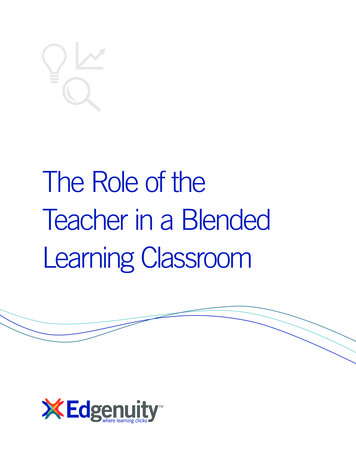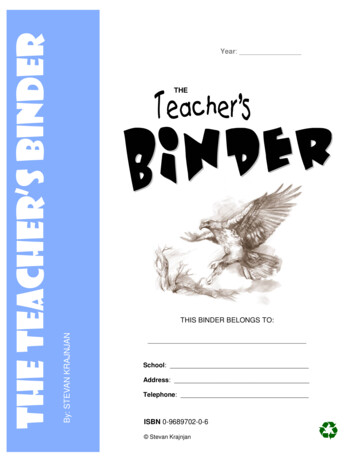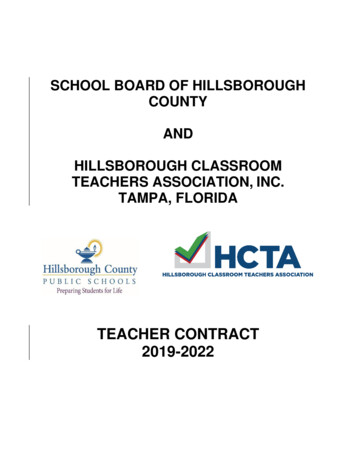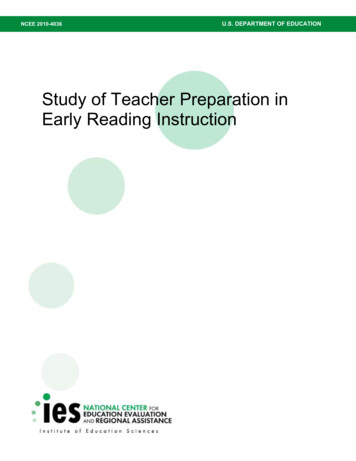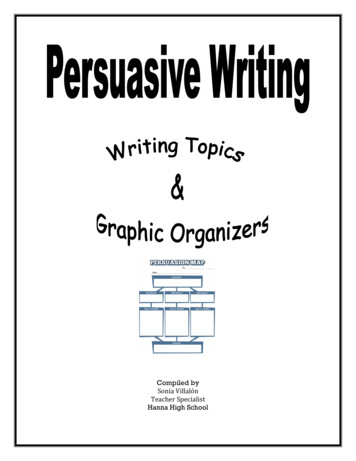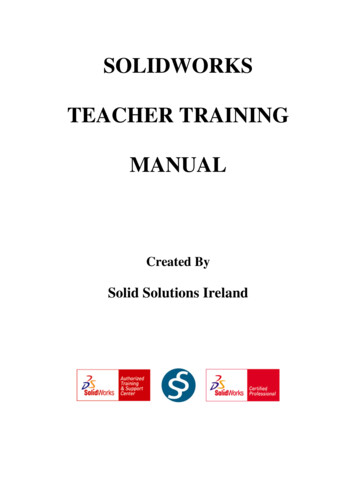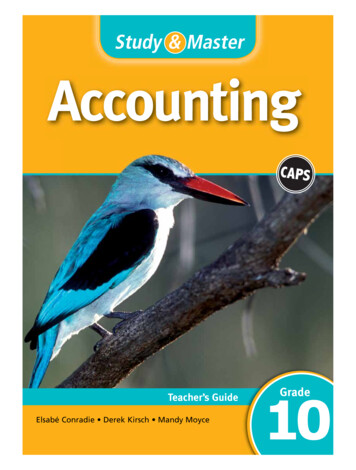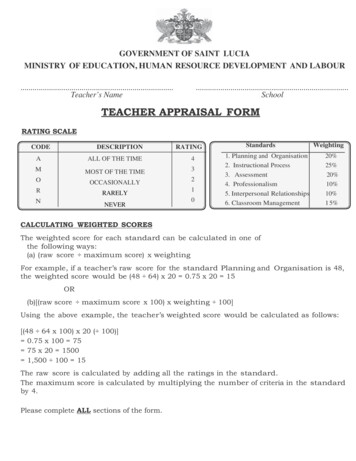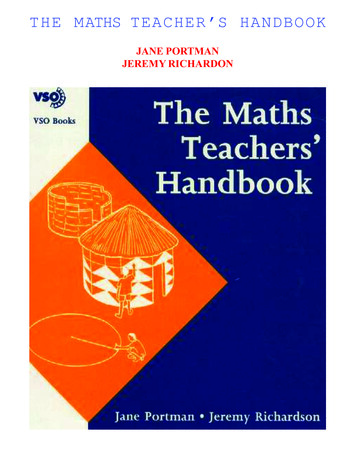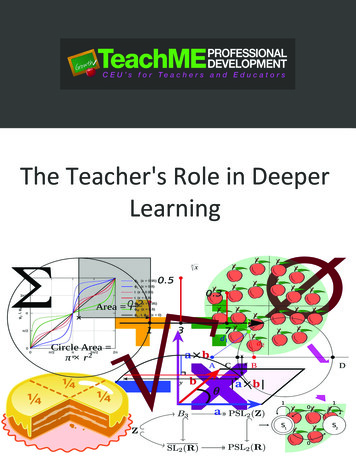
Transcription
The Teacher's Role in DeeperLearning
INTRODUCTION“What sort of endeavor is teaching?” The answer seems simple: One in which knowledge and skillsare transmitted.All true, but not all that is true. One might also say that teachers try to improve their students’minds, souls, habits.—David K. Cohen (2011), from Teaching and its Predicaments (p. 4)The Hewlett Foundation defines deeper learning as “anumbrella term for the skills and knowledge that studentsmust possess to succeed in 21st-century jobs and civiclife” (Hewlett Foundation 2013). Under that umbrella fit aset of competencies that “students must master in orderto develop a keen understanding of academic contentand apply their knowledge to problems in the classroomand on the job.” These competencies include: mastercore academic content; think critically and solve complexproblems; work collaboratively; communicate effectively;learn how to learn; and develop academic mindsets.What do these deeper learning competencies imply for thework of teaching? What does one do in a classroom to movestudents’ minds, souls, and habits in their direction? Thispaper addresses these questions.What Would Teaching for Deeper LearningNeed to Accomplish?Most students in most secondary schools are accustomedto learning in two ways: by listening to the teacher andreading books and other texts (Mehta & Fine 2015; Cusick1983; Graff 2003). In a sense, these familiar ways oflearning or “doing school” work for them because whatthey are expected to know and be able to do tends tobe intellectually shallow (Jennings 2012; Cawelti 2006).However, if they are going to be expected to meet deeperlearning expectations, their everyday experiences in theclassroom will have to look quite different.First, “mastering core academic content,” as Hewlettdefines it, involves more than remembering terms, facts,dates, and formulas. It means understanding “key principlesand relationships within a content area and organiz[ing]information in a conceptual framework.” Putting thattogether with the expectation that students should beable to “think critically and solve problems” suggests amore active and personal intellectual process than thefamiliar scholastic exercises of copying, memorizing, andreproducing a framework developed by someone else(Bransford et al. 2000). This process calls for what Cohenrefers to as “minds at work” (Cohen 2011).This, then, is the first set of questions we need to ask ifwe want reconsider what we mean by teaching in light ofthe goals of deeper learning: How, exactly, does one teacha “conceptual framework” or instruct students on how toconstruct conceptual frameworks of their own? Whose wayof organizing information in a domain do we choose toteach? Should we ask students to organize information intotheir own unique categories and relationships? If so, shouldthey do that work independently or with our guidance?Second, Hewlett’s definition of deeper learning requiresthat students learn “communication and collaboration,”which means they cannot just work on their own. Rather,they need to “reason critically and solve problems” inthe company of others doing the same activities. Thisalso affects how we think about the work of teaching.Communication and collaboration are best learned inwhat some scholars call “a community of practice,” whereshared norms and common ways of defining problems(and the nature of solutions) are fundamental to learning(Weick & McDaniel 1989; Wenger 1998; Rogoff et al.1995). We have to ask, then: What does a teacher do toget students to interact with one another in these ways?How much preparation does a teacher do before studentscommunicate and collaborate, and to what extent doteachers just improvise?JOBS FOR THE FUTURE1
If I wanted to learn, say, the names of the countriesinvolved in the 20th-century world wars, I might study alist I had been “taught” by a reliable book or teacher. If Ithen succeed in reciting or writing down that informationwhen asked to do so, I might be justified in saying that I had“learned” it.But to learn how to think critically, collaborate, andcommunicate requires an entirely different approach.Learning how to do these things requires that I actuallydo them, just as learning how to swim requires that I swim(however badly, at first). “Learning” here is both the goaland the means of getting to the goal (Sfard 2008). Itrequires not just a mind at work but a mind working onmeaningful tasks, in concert with others.In order to solve complex problems collaboratively, I needto practice solving them, expose my solutions to others’scrutiny, and persist in trying various approaches. I won’tlearn to solve problems collaboratively by reading booksor listening to lectures, though books and lectures aboutcollaborative problem solving might be useful resources.To become skilled at communicating effectively, I needto express my ideas in spoken or written language; if myaudience doesn’t “get” what I am trying to say or write,then I need to figure out how to revise it and try again(Staples & Truxaw 2010; Horn 2012). In taking on the taskof convincing others to change their minds, I need to openmyself up to social risks that are not usually associated withschoolwork. If I am the teacher, I need to ask: In order toget students to reason, collaborate, and communicate withone another, what kinds of instruction are needed? How canteachers be of assistance?Finally, deeper learning is as much about who we wantstudents to become—intellectually, at least—as it is aboutwhat we want them to possess. According to Hewlett,“learning how to learn” (the fifth competency) requires“caring about the quality of one’s work, enjoying andseeking out learning on your own and with others.” Thishas more to do with commitment and interest than skillsand knowledge per se. Similarly, to “develop academicmindsets” means that students:Develop positive attitudes and beliefs about themselvesas learners that increase their academic perseveranceand prompt them to engage in productive academicbehaviors [so that they are] committed to seeing work2DEEPER LEARNING RESEARCH SERIES DEEPER TEACHINGthrough to completion, meeting their goals and doingquality work, and thus search for solutions to overcomeobstacles (Hewlett Foundation 2013).It goes without saying that such desires, attitudes,and beliefs are shaped, at least in part, by the kinds ofinteractions students have with peers and adults, bothin and out of school (Roeser et al. 2000; Wortham 2004;Gordon 2000; Greeno 2001). Students learn how to learnand shape their identities with regard to academic work byparticipating in many such exchanges over time.1 But what,exactly, does teaching look like in these exchanges? Andhow do teachers persuade students to invest more of theirtime, and more of themselves, in their academic work?Given what we know about U.S. adolescents, it seemsreasonable to assume that for most high school students,it will be impossible to build deeper learning competencieswithout simultaneously changing what they care about and,in a sense, who they are (Eckert 1989, 1990).2 For example,in the 2009 Survey of Student Engagement (IndianaUniversity, Bloomington), 62 percent of those surveyed saidthat their “top priority” was to play video games, surf theweb, talk on the phone, or socialize outside of school, andthe daily number of hours they reported spending on theseactivities was roughly proportional to the importance theyassigned them. In short, teaching for deeper learning willneed to support a kind of “identity transformation,” as wellas providing students with different ways to learn differentkinds of content. The question is, how does a teachersupport students in building new identities, changing theirpriorities, and choosing to dig into academic content?If learning deeply requires students to be so bold as tochange the ways in which they identify themselves andtheir interests, then teachers must support the risksinvolved in that change, as well. And if learning requirescertain kinds of social interaction, then teaching needs tostructure that interaction to provide the experiences thatshape a student’s scholarly self and make it safe to ventureinto new territory.The teaching that results from answering the questionsabove will not be teaching as we have known it over thepast century or longer (Cohen 1988, 2011; Cuban 1993).Perhaps all teaching changes students’ minds, souls, andhabits, as Cohen claims, but teaching for deeper learningdoes so deliberately, with specific and well-articulated ends.
TWO WAYS OF TEACHING:A COMPARISONIn order to determine whether teaching or learning is “deep,” we first must be sure that the teacherand students are working on material that is in fact worth learning. So I begin this section byintroducing a bit of the “core content” that is widely understood to be central to the secondaryschool curriculum. I then describe—based on my own classroom observations—how two teacherstaught that content and what students did to learn it. While I focus on the details of these twolessons, one in a classroom focused on deeper learning, the other not, it will become clear thatdeeper teaching extends well beyond the lesson itself. It requires us to base every interactionbetween teachers and learners on a new understanding of what it means to teach and learn.The first lesson typifies the most common sort ofinstruction in secondary schools across the U.S. (Mehta& Fine 2015; Cusick 1983, 1973; Graff 2003). The secondfeatures a teacher who is at the same point in thecurriculum, teaching the same subject, but trying topractice what I call “deeper teaching” to support students’deeper learning. Such teaching is, comparatively, bothintellectually and socially ambitious (Cohen 2011; Lampert& Graziani 2009; Newmann & Associates 1996). Overthe next several pages, I put these two lessons under amicroscope, focusing on moment-by-moment exchangesbetween the teachers and their students, in order to callprecise attention to what it means to teach deeply, howsuch teaching differs from the norm, and what sorts ofknowledge and skills it requires. I conclude by offering somethoughts on what it will take to promote and sustain suchdeeper teaching on a large scale.I suspect that the interactions between teacher andstudents in the first teacher’s lesson will seem entirelyfamiliar to most readers. After all, these are the activitiesthat many of us picture when we imagine a typicalclassroom: the teacher talks, usually to the whole classfrom the front of the room; the talk “explains” facts orprocedures; and the class, sitting in desks facing theteacher, takes notes on what the teacher says or writeson the board.3 If students talk at all, they provide answersto the teacher’s questions, which the teacher judges to becorrect or incorrect (Sims 2008; Holt 1969). This form ofteaching has persisted in the U.S. for more than a century(Cohen 1985; Cuban 1993; Mehta & Fine 2015). Individualteachers don’t invent it—it is a re-enactment of the way theywere taught (Lortie 1975; Sam & Ernest 2000; Barkatsas,Tasos & Malone 2005), and it is what many students andparents expect of them.The second lesson presents a very different picture.Students talk to one another, collaborating andcommunicating as they make sense of a complex problem.The teacher moves and talks in ways that engage studentspublicly as learners, listening to and representing theirthinking for consideration by the whole class.The teacher moves and talks in ways that engage students publiclyas learners, listening to and representing their thinking forconsideration by the whole class.JOBS FOR THE FUTURE3
Although some teachers may find their own way to aform of deeper teaching—perhaps seeing themselves asmavericks, standing apart from their peers—the teacher inthis example did not invent deeper teaching any more thanthe teacher in the first example invented her approach.Rather, her lesson was developed as a part of a purposefuleffort to design instruction and professional learning thatdeliberately organizes interactions between teachers andlearners to bring about the kinds of competencies thatcharacterize deeper learning.Both of the lessons are more or less consistent with theways in which these two teachers taught throughout theschool year, and they are representative of the regularpatterns of interaction—what some scholars call the “cultureof instruction”—that characterized each classroom (Deal &Peterson 1999, 2009).By participating in such a culture over time, individualsin a classroom environment learn the answers to basicquestions about what it means to be a learner and ateacher (e.g. How are teachers supposed to act? Howare students supposed to act? What are teachers andstudents supposed to say to one another? What are theysupposed to believe? How are they supposed to relate toone another?) (Goos 2004; Horn 2012). Participating in aclassroom culture is also how students learn what they are“good at” and whether or not that includes academics. Inother words, classroom interactions—especially the sharedculture, norms, and language that their teachers help themto create—develop each student’s “mindset” about whetherthey can, or want to, succeed in school.an introduction to a powerful mathematical language thatpeople use to describe patterns and make predictions. It canbe an opportunity to learn how to learn in new ways. It canopen up access to social and economic resources (Moses &Cobb 2001). Or it can be an exercise in memorizing formulasand rules, as is the case in much U.S. education.For students to achieve mastery of the core content ofalgebra, they need to study functions, i.e., mathematicalrelationships in which one quantity changes in relation toanother. Here, I look at two lessons that have to do with therate of change of a linear function. Mastering the conceptof rate of change (sometimes referred to as slope)4 enablesus to think productively about problems like how to financean expensive purchase, determine the safest gradient for aroad, or design an engine. It can be a useful tool for makingimportant decisions both in work and in civic life.5 The newsis full of stories whose meaning can only be grasped byseeing how one event is a function of another (Ritchhardt1997). Students who understand functions and their ratesof change can go on to study calculus, the mathematicalgateway to engineering, medicine, economics, informationtechnology, and many other fields.When they study rate of change, students begin by workingwith linear functions, so named because represented on acoordinate graph6 they look something like this:y-axisy x 2An Example of “Core Content”From within the current subject-based organizationof secondary schools, I have chosen to discuss twomathematics lessons. By writing from this perspective,I am not taking a stand for or against “siloed” schoolorganization, where math is taught separately from science,history and literature. Instead, I merely want to suggest thatdeeper learning, and deeper teaching, are possible withinthe familiar curricular framework, and that curriculumin turn can be relevant to solving complex, on-the-jobproblems in many fields.I focus here on algebra, which is usually taught as a distinctsubject area sometime between eighth and tenth grade(though some elements of algebraic thinking may belearned in earlier grades). Studying algebra can provide4DEEPER LEARNING RESEARCH SERIES DEEPER TEACHINGx-axisThe line on this graph tells us that no matter what quantitywe start with (“x”)—whether it is expressed as a wholenumber or a fraction, whether it is greater or less thanzero—the related quantity (“y”) is always two units larger.For this kind of function, it is possible to extrapolate
Studying functions and their graphs can be an opportunityto learn how to learn about this very important idea, and tolearn how to use it to think critically about mathematicalstatements and solve mathematical problems. It can be akey to “belonging” to the community of learners who knowthey can succeed at math in high school. Or it can leadstudents to believe that math doesn’t make sense and/or they are not smart enough to get it. Whether or not astudent comes out of the study of functions having madeprogress toward the deeper learning competencies dependson how the content is taught. As the following two lessonssuggest, teachers can teach functions in very differentways. My purpose is not to compare two particular teachers,but to compare two different kinds of teaching.Teacher A: Providing a ConventionalIntroduction to SlopeIn the first math classroom, Ms. A stands at the board infront of her class, beginning a lesson that focuses on rateof change in linear functions.7 The goal of the lesson isprojected on a screen at the front of the room:They have not yet talked about what it means—or why itmatters—if the line slants up or down or goes horizontallyacross the graph, or if it is “steep” or “gentle”.Before working with the table of ordered pairs, the studentshave copied this definition of a function from the boardinto their notebooks: “A function is a relation between a setof inputs and a set of outputs with the property that eachinput is related to exactly one output.” On the same page,they have also written:input xoutput yAt the beginning of the lesson, Ms. A draws a horizontal linecrossing a vertical line on the board. Standing next to thedrawing, she gestures up and down, then left to right,saying, “The graph is divided into four quadrants by twoaxes: the horizontal x-axis, and the vertical y-axis.” She thenputs arrowheads at the ends of the lines, and writes an x tothe right of the horizontal line and a y at the top of thevertical line. Pointing to their intersection, she says thatthey cross at a point called the “origin.” (The words“quadrant,” “horizontal,” “vertical,” “axis,” and “origin” areprojected on a screen next to what she refers to as the“graph.”) Next, she ticks off equal segments on both linesand puts numbers next to them. She then draws a diagonalline from the top right to the bottom left of the graph, andshe darkens and labels two points on that line, resulting in apicture that looks like this:4*ySWBAT find the slope of a line given two ordered pairs.xy0-1352437(2, 3)3Ms. A tells her class that this is their introduction to “slope,”and they will connect finding slope to graphing lines. For afew days, they have been graphing lines using tables ofordered pairs like this one:21x-3-2-11-1234(0, -1)-2-3*SWBAT is a common acronym in classrooms, used to abbreviate “Students Will Be Able To.” It is always stated in terms of an action that students shouldbe able to perform by the end of the lesson if they learn what is being taught.JOBS FOR THE FUTURE5TWO WAYS OF TEACHING: A COMPARISONimportant information about how y changes in relation tox from just two pieces of data: the slope of the line and thepoint where it crosses the vertical line that goes throughthe origin (called the “y-intercept”). We can predict what ywill be for any x, no matter how great or tiny the quantity.The lines on the graph above have arrows on their endsbecause they represent only a small part of infinite linesreaching in both directions.
She then reads from a projection on a screen next to theboard: “Remember, every point on the graph can be labeledwith two numbers, x and y, and indicated by the orderedpair (x, y).” This is review. Ms. A’s students wrote this intheir notebooks when they first learned to use tables likethe one above to make the corresponding dots on a graphand connect them with a line. The only x and y on the boardare the ones labeling the x- and y-axes; the letters are notvisually associated with a point on the graph. One of thestudents asks the boy next to him whether the “y” on top ofthe vertical line and the “x” next to the horizontal line haveanything to do with the (x, y) on the screen. He does not askthe teacher his question, becau
it will be impossible to build deeper learning competencies without simultaneously changing what they care about and, in a sense, who they are (Eckert 1989, 1990).2 For example, in the 2009 Survey of Student Engagement (Indiana Un
